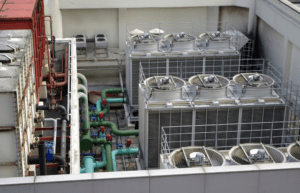When you reach for the thermostat in your business, you may simply expect the system to “just work.” What’s actually going on behind the scenes when you flip that switch, though? Most commercial cooling solutions operate on the same general principles, but what about the commercial heating your employees rely upon for warmth during the colder months? There are many different options on the market, each with unique strengths and drawbacks that make them suitable for particular applications. Determining if you have the ideal solution in place for your business starts with developing a clearer understanding of the options. If you need commercial heating systems explained in an easy-to-understand format, use this guide to get started.
What to Know About the Different Types of Commercial Heating Solutions
This system is the type most people think about when they consider commercial heating hardware, in part because it is the most common type of residential system. In a central forced-air system, the HVAC ducts’ network circulates air driven by a powerful blower fan throughout the building, while return ducts bring air back into the loop. Forced air systems can use fuel or electricity as a power source.
Central Forced Air:
This system is the type most people think about when they consider commercial heating hardware, in part because it is the most common type of residential system. In a central forced air system, a network of HVAC ducts circulates air driven by a powerful blower fan throughout the building, while return ducts bring air back into the loop. Forced air systems can use fuel or electricity as a power source.
Fuel-burning furnaces use fuel oil or, more commonly, clean-burning natural gas. The combustion heats a metal heat exchanger, and the blower fan moves air past these components. While electric systems may rely on resistance coils to heat the air instead of a flame, they are not common in commercial contexts due to their higher operational cost. Instead, commercial heating based on electricity often relies on a heat pump instead.
Heat pumps use a pressurised refrigerant system, like an air conditioner, to pull heat out of the air outside and bring it indoors. Commercial heat pumps are well adapted to zoned heating systems, and can even allow different parts of the building to undergo heating and cooling simultaneously and separately. When appropriately sized and professionally installed, central forced air heaters provide robust performance for commercial spaces. Ask a professional HVAC technician if a heat pump could handle your commercial heating requirements on its own
Water Heating:
Popular in very large buildings and older structures without ducting, commercial heating through hot water involves boilers instead of furnaces. The water heated in these vessels circulates into radiators or tubes in the walls and floors to release heat slowly into the space. Commercial boilers can be extremely powerful and offer a generally energy-efficient mode of heating. However, they require substantially more maintenance than other heating options and can be expensive to install in buildings which may do better by using existing ductwork for a central system. Nonetheless, boilers remain in widespread use, and new innovations continue to boost their efficiency, too.
Geothermal Heating:
One of the proverbial “new kids on the block” in the commercial space, these commercial heating systems can be explained in much the same way as an electric heat pump with one major difference. A regular heat pump pulls warmth from the air outside; a geothermal unit relies on heat trapped underground to warm the building. Though expensive to install due to the excavations necessary, geothermal systems can yield impressive efficiencies. These systems work best in areas with milder winters, as there is a limit to how much heat such a system can remove from the ground.
Other Commercial Heating Options
There are some additional choices which may present themselves as options for businesses looking to “go green” with their commercial heating:
- Radiant heating works similarly to the way boilers operate, but uses special plastic tubing and may not always use water as the heat exchange medium. Though radiant hydronic systems are growing in popularity, they remain rare in large-scale commercial heating applications. Radiant systems rely on the thermodynamic principle of heat transfer, which says that heat always tends to move towards colder spaces.
- Active solar heating requires an investment of cash, time, and space to install enough solar panels to power a hydronics-based system that expresses heat indoors. In some cases, businesses use passive solar heating instead — that is, a building design that encourages natural heat absorption.
Seek a Professional to Have Commercial Heating Systems Further Explained
Is your building still relying on an old oil-fired furnace? Is it an older natural gas unit that’s started to show its age? Could your building benefit from a different solution than what you’re using today? Answering these questions and exploring their possible effects on your energy budget starts with having commercial heating systems explained, but it doesn’t end there. Instead, the next step is to arrange a discussion with a commercial heating professional to discuss your building’s requirements. With exciting advances in this arena still on the horizon, many businesses have the potential to realize notable energy savings.

